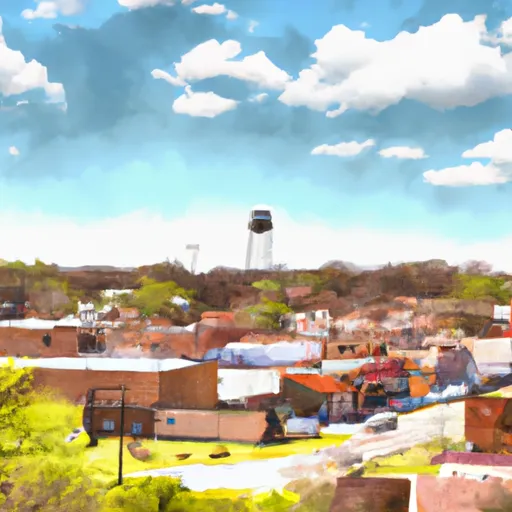-
 Snoflo Premium
Snoflo Premium
Get unlimited access to all our content
With no Ad interruptions! - Start Your Free Trial Login with existing account
Spavinaw
Eden Index
Climate
8.3
•
Recreation
2.6
•
Community
•
Safeguard
4.2/10

Spavinaw, Oklahoma, is a small town located in Mayes County. Known for its picturesque landscapes and outdoor recreational opportunities, Spavinaw offers a unique experience for nature enthusiasts. The town features a humid subtropical climate, characterized by hot summers and mild winters.
Hydrology plays a significant role in Spavinaw's appeal, as it is home to the Spavinaw Creek, a major tributary of the Grand River. The creek provides a natural habitat for various aquatic species and serves as a source of drinking water for many nearby communities. The crystal-clear waters make it ideal for fishing, kayaking, and canoeing.
Outdoor recreation opportunities abound in Spavinaw, with several parks and trails to explore. Spavinaw State Park offers camping, hiking, and picnicking facilities, allowing visitors to immerse themselves in the scenic beauty of the area. The park also offers a swimming beach, allowing visitors to cool off during the hot summer months. For those who enjoy fishing, the lake is stocked with bass, crappie, and catfish, ensuring an enjoyable angling experience.
Overall, Spavinaw, Oklahoma, provides a serene and natural environment, making it a preferred destination for those seeking outdoor adventures and a break from city life.
What is the Eden Index?
The Snoflo Eden Index serves as a comprehensive rating system for regions, evaluating their desirability through a holistic assessment of climate health, outdoor recreation opportunities, and natural disaster risk, acknowledging the profound impact of these factors on livability and well-being.
Climate Health Indicator (CHI): 8.3
Spavinaw receives approximately
1117mm of rain per year,
with humidity levels near 81%
and air temperatures averaging around
16°C.
Spavinaw has a plant hardyness factor of
7, meaning
plants and agriculture in this region tend to thrive during the non-winter months.
By considering the ideal temperature range, reliable water supplies, clean air, and stable seasonal rain or snowpacks, the Climate Health Indicator (CHI) underscores the significance of a healthy climate as the foundation for quality living.
A healthy climate is paramount for ensuring a high quality of life and livability in a region, fostering both physical well-being and environmental harmony. This can be characterized by ideal temperatures, reliable access to water supplies, clean air, and consistent seasonal rain or snowpacks.
Weather Forecast
Streamflow Conditions
Neosho
Area Rivers
Neosho
Snowpack Depths
Neosho
Reservoir Storage Capacity
Neosho
Groundwater Levels
Recreational Opportunity Index (ROI): 2.6
The Recreational Opportunity Index (ROI) recognizes the value of outdoor recreational options, such as parks, hiking trails, camping sites, and fishing spots, while acknowledging that climate plays a pivotal role in ensuring the comfort and consistency of these experiences.
Access to outdoor recreational opportunities, encompassing activities such as parks, hiking, camping, and fishing, is crucial for overall well-being, and the climate plays a pivotal role in enabling and enhancing these experiences, ensuring that individuals can engage in nature-based activities comfortably and consistently.
Camping Areas
| Campground | Campsites | Reservations | Toilets | Showers | Elevation |
|---|---|---|---|---|---|
| Gore Landing | 22 | 464 ft | |||
| Brewers Bend - Webbers Falls Lake | None | 529 ft | |||
| Little River - Pine Creek Lake | None | 537 ft | |||
| Raymond Gary State Park | None | 480 ft | |||
| John Wells Park | None | 686 ft | |||
| Pine Creek Cove - Pine Creek Lake | None | 462 ft | |||
| Arrowhead Point - Webbers Falls Lake | None | 530 ft | |||
| Talimena State Park | None | 1,064 ft | |||
| Lost Rapids - Pine Creek Lake | None | 492 ft | |||
| Turkey Creek - Pine Creek Lake | 31 | 458 ft |
Nearby Fishing
Catastrophe Safeguard Index (CSI):
The Catastrophe Safeguard Index (CSI) recognizes that natural disaster risk, encompassing floods, fires, hurricanes, and tornadoes, can drastically affect safety and the overall appeal of an area.
The level of natural disaster risk in a region significantly affects safety and the overall livability, with climate change amplifying these risks by potentially increasing the frequency and intensity of events like floods, fires, hurricanes, and tornadoes, thereby posing substantial challenges to community resilience and well-being.
Community Resilience Indicator (CRI):
The Community Resilience Indicator (CRI) recognizes that education, healthcare, and socioeconomics are crucial to the well-being of a region. The CRI acknowledges the profound impact of these elements on residents' overall quality of life. By evaluating educational resources, healthcare accessibility, and economic inclusivity, the index captures the essential aspects that contribute to a thriving community, fostering resident satisfaction, equity, and social cohesion.

